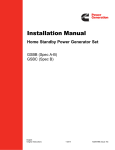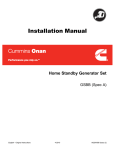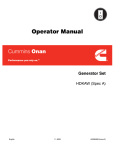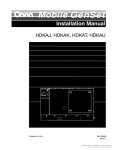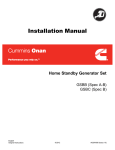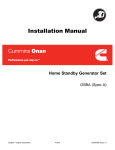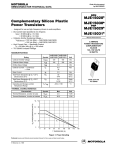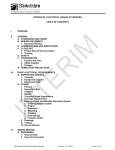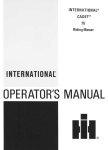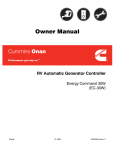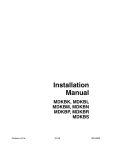Download 965-0601C Onan GHAB (spec A) Genset Installation manual
Transcript
Installation Manual GHAB Printed in U. S. A. 965-0601C 3-2003 Redistribution or publication of this document, by any means, is strictly prohibited. Supplement 965-1079 Date: 2-2004 Insert withTitle: GHAB Installation Manual Number: 965-0601C PURPOSE This publication adds supplementary information to the following page of the GHAB Installation Manual. Page 3-4: Revised conversion procedure to include brass elbow. SUPPLEMENT USE Replace page 3−3/3−4 with the attached. Please keep this supplement with the Installation Manual (965-0601C). i Redistribution or publication of this document, by any means, is strictly prohibited. ii Redistribution or publication of this document, by any means, is strictly prohibited. appliances such as a furnace, water heater, or stove, you must consult with the local natural gas utility to determine whether the natural gas meter is adequate. NATURAL GAS FUEL SYSTEM The genset requires an adequate fuel supply to operate correctly at full load. The length of the fuel supply pipe from the gas service entrance to the genset must be known to determine the correct fuel pipe size. Refer to Table 3-1 to find the fuel supply requirement for your genset. Pipe must be minimum of schedule 40 subject to the authority having jurisdiction. It is important to consider other loads operated from the fuel supply pipe. Other loads, such as space heating and water heating equipment, must also be determined to correctly size the fuel pipe. Use the total load requirement of the fuel supply line to determine the size of the fuel supply pipe. Use Table 3-1 to determine the correct pipe size. (typically, 1 ft3/hr =1000 BTU/hr, ) Natural Gas Supply Line Size The genset requires up to 240,000 BTU/hr (240 cubic feet/hr) delivered to the genset inlet at 11 inches (28 mm) WC, nominal. If the meter serves other gas When the fuel delivery value falls between two columns, use the larger value. GENSET SHUTOFF VALVE GAS METER ÎÎÎÎÎÎÎÎÎÎÎÎÎÎÎÎÎÎÎÎÎÎÎÎÎÎÎÎÎÎÎÎÎÎ ÎÎÎÎÎÎÎÎÎÎÎ ÎÎÎÎÎÎÎÎÎÎÎÎÎÎÎÎÎÎÎÎÎÎÎÎÎÎÎÎÎÎÎÎÎÎ ÎÎÎÎÎÎÎÎÎÎÎÎÎÎÎÎÎÎÎÎÎÎÎÎÎÎÎÎÎÎÎÎÎÎ FIGURE 3-2. TYPICAL NATURAL GAS INSTALLATION TABLE 3-1. NATURAL GAS PIPE CAPACITY—CUBIC FEET OF GAS PER HOUR Maximum pipe capacity in cubic feet per hour of 0.60 specific gravity natural gas with a pressure drop of 0.5 inches (1.27 mm) WC over the length NOMINAL IRON PIPE SIZE (INCHES) 10 20 30 40 50 60 70 80 90 100 125 150 175 200 3/4 360 250 200 170 151 138 125 118 110 103 93 84 77 72 1 680 465 375 320 285 260 240 220 205 195 175 160 145 135 1-1/4 1400 950 770 660 580 530 490 460 430 400 360 325 300 280 LENGTH OF PIPE IN FEET 3-3 Redistribution or publication of this document, by any means, is strictly prohibited. 5. Replace the access panel. Set it in the bottom of the opening, swing it up, turn the latch clockwise, and fold up to secure the panel. LP VAPOR FUEL SYSTEM Fuel leaks can lead to explosive accumulations of gas. Natural gas rises and can accumulate under overhanging hoods and inside housings and buildings. LP Vapor sinks air and can accumulate inside housings, basements and other below-grade spaces. Prevent gas leaks and the accumulation of gaseous fuel in the event of a leak. WARNING ELBOW ORIFICE (EARLY PRODUCTION ONLY) NFPA Standard No. 58 requires all persons handling and operating LP Vapor to be trained in proper handling and operating procedures. Converting from Natural Gas to LP Vapor The genset leaves the factory set up for natural gas. The genset must be converted to use LP Vapor. Conversion on early production units involves inserting an orifice into the brass elbow (See Figure 3-3). Later production units use a replacement elbow with a smaller ID, and is marked with a red dot on the elbow. All conversions require adjusting the carburetor (See Figure 3-4). The genset is shipped with a kit containing the orifice for conversion. ORIFICE OR NEW ELBOW FOR LP VAPOR A genset purchased to use Natural Gas or LP Vapor can not be converted to use LP Liquid, and one that is purchased to use LP Liquid can not be converted to use Natural Gas or LP Vapor. FIGURE 3-3. NATURAL GAS TO LP VAPOR CONVERSION Conversion Procedure (Natural Gas to LP Vapor): ADJUSTMENT SCREW 1. Remove access panel on the control side of the genset. Lift handle up and out, then turn counter-clockwise, swing the access panel down, and lift out. 2. Remove the elbow following the regulator in the fuel line (Figure 3-3). 3a. For early production units, insert the orifice into the elbow (smaller end into the elbow first) and reinstall the elbow. CARBURETOR (MIXER) 3b. For later production units, install the replacement elbow from the conversion kit that has been marked with a red dot. 4. Turn the carburetor (mixer) idle screw from all the way in (original factory setting) out so that the top of screw is flush with the body of the carburetor. See Figure 3-4. FIGURE 3-4. CARBURETOR ADJUSTMENT 3-4 Redistribution or publication of this document, by any means, is strictly prohibited. - ! ! The engine exhaust from this product contains chemicals known to the State of California to cause cancer, birth defects or other reproductive harm. Redistribution or publication of this document, by any means, is strictly prohibited. Table of Contents TITLE PAGE SAFETY PRECAUTIONS . . . . . . . . . . . . . . . . . . . . . . . . . . . . . . . . . . . . . . . . . . . . . . . . . . . . II 1. INTRODUCTION . . . . . . . . . . . . . . . . . . . . . . . . . . . . . . . . . . . . . . . . . . . . . . . . . . . . . . . . . 1-1 About this Manual . . . . . . . . . . . . . . . . . . . . . . . . . . . . . . . . . . . . . . . . . . . . . . . . . . . . . . Pre-Installation Considerations . . . . . . . . . . . . . . . . . . . . . . . . . . . . . . . . . . . . . . . . . . . Installation Overview . . . . . . . . . . . . . . . . . . . . . . . . . . . . . . . . . . . . . . . . . . . . . . . . . . . . Installation Codes and Safety Recomendations . . . . . . . . . . . . . . . . . . . . . . . . . . . . . 1-1 1-1 1-3 1-3 2. STEP-BY-STEP INSTALLATION OUTLINE . . . . . . . . . . . . . . . . . . . . . . . . . . . . . . . . . 2-1 Introduction . . . . . . . . . . . . . . . . . . . . . . . . . . . . . . . . . . . . . . . . . . . . . . . . . . . . . . . . . . . . Locating the Site . . . . . . . . . . . . . . . . . . . . . . . . . . . . . . . . . . . . . . . . . . . . . . . . . . . . . . . . Genset Clearances . . . . . . . . . . . . . . . . . . . . . . . . . . . . . . . . . . . . . . . . . . . . . . . . . . . . . Preparing the Site . . . . . . . . . . . . . . . . . . . . . . . . . . . . . . . . . . . . . . . . . . . . . . . . . . . . . . Moving the Genset . . . . . . . . . . . . . . . . . . . . . . . . . . . . . . . . . . . . . . . . . . . . . . . . . . . . . . Placing the Genset . . . . . . . . . . . . . . . . . . . . . . . . . . . . . . . . . . . . . . . . . . . . . . . . . . . . . . Connecting the Genset . . . . . . . . . . . . . . . . . . . . . . . . . . . . . . . . . . . . . . . . . . . . . . . . . . 2-1 2-1 2-2 2-3 2-4 2-5 2-6 3. MECHANICAL . . . . . . . . . . . . . . . . . . . . . . . . . . . . . . . . . . . . . . . . . . . . . . . . . . . . . . . . . . . 3-1 Location . . . . . . . . . . . . . . . . . . . . . . . . . . . . . . . . . . . . . . . . . . . . . . . . . . . . . . . . . . . . . . . Access and Mounting . . . . . . . . . . . . . . . . . . . . . . . . . . . . . . . . . . . . . . . . . . . . . . . . . . . Engine Exhaust . . . . . . . . . . . . . . . . . . . . . . . . . . . . . . . . . . . . . . . . . . . . . . . . . . . . . . . . . Fuel System . . . . . . . . . . . . . . . . . . . . . . . . . . . . . . . . . . . . . . . . . . . . . . . . . . . . . . . . . . . Natural Gas Fuel System . . . . . . . . . . . . . . . . . . . . . . . . . . . . . . . . . . . . . . . . . . . . . . . . LP Vapor Fuel System . . . . . . . . . . . . . . . . . . . . . . . . . . . . . . . . . . . . . . . . . . . . . . . . . . . LP Liquid Fuel System . . . . . . . . . . . . . . . . . . . . . . . . . . . . . . . . . . . . . . . . . . . . . . . . . . 3-1 3-1 3-2 3-2 3-3 3-4 3-7 4. ELECTRICAL CONNECTIONS . . . . . . . . . . . . . . . . . . . . . . . . . . . . . . . . . . . . . . . . . . . . 4-1 Conduit . . . . . . . . . . . . . . . . . . . . . . . . . . . . . . . . . . . . . . . . . . . . . . . . . . . . . . . . . . . . . . . . Control and Power Connections . . . . . . . . . . . . . . . . . . . . . . . . . . . . . . . . . . . . . . . . . . Grounding . . . . . . . . . . . . . . . . . . . . . . . . . . . . . . . . . . . . . . . . . . . . . . . . . . . . . . . . . . . . . Transfer Switch . . . . . . . . . . . . . . . . . . . . . . . . . . . . . . . . . . . . . . . . . . . . . . . . . . . . . . . . . Battery . . . . . . . . . . . . . . . . . . . . . . . . . . . . . . . . . . . . . . . . . . . . . . . . . . . . . . . . . . . . . . . . 4-1 4-1 4-3 4-4 4-8 5. INSTALLATION REVIEW AND STARTUP . . . . . . . . . . . . . . . . . . . . . . . . . . . . . . . . . . . 5-1 Installation Review . . . . . . . . . . . . . . . . . . . . . . . . . . . . . . . . . . . . . . . . . . . . . . . . . . . . . . 5-1 Startup . . . . . . . . . . . . . . . . . . . . . . . . . . . . . . . . . . . . . . . . . . . . . . . . . . . . . . . . . . . . . . . . 5-1 6. SPECIFICATIONS . . . . . . . . . . . . . . . . . . . . . . . . . . . . . . . . . . . . . . . . . . . . . . . . . . . . . . . . 6-1 7. DRAWINGS . . . . . . . . . . . . . . . . . . . . . . . . . . . . . . . . . . . . . . . . . . . . . . . . . . . . . . . . . . . . . 7-1 GHAB Genset Outline Drawing . . . . . . . . . . . . . . . . . . . . . . . . . . . . . . . . . . . . . . . . . . . 7-1 GHAB Wiring Diagram . . . . . . . . . . . . . . . . . . . . . . . . . . . . . . . . . . . . . . . . . . . . . . . . . . 7-2 RSZ Transfer Switch Drawings . . . . . . . . . . . . . . . . . . . . . . . . . . . . . . . . . . . . . . . . . . . 7-3 i Redistribution or publication of this document, by any means, is strictly prohibited. Safety Precautions • Used engine oil has been identified by some state and federal agencies as causing cancer or reproductive toxicity. Do not ingest, inhale, or contact used oil or its vapors. Thoroughly read the OPERATOR’S MANUAL before operating the genset. Safe operation and top performance can be obtained only when equipment is operated and maintained properly. • Do not work on the genset when mentally or physically fatigued or after consuming alcohol or drugs. The following symbols in this manual alert you to potential hazards to the operator, service person and equipment. • Carefully follow all applicable local, state and federal codes. alerts you to an immediate hazard which will result in severe personal injury or death. GENERATOR VOLTAGE IS DEADLY! • Generator output connections must be made by a qualified electrician in accordance with applicable codes. alerts you to a hazard or unsafe practice which can result in severe personal injury or death. WARNING • The genset must not be connected to the public utility or any other source of electrical power. Connection could lead to electrocution of utility workers and damage to equipment. An approved switching device must be used to prevent interconnections. alerts you to a hazard or unsafe practice which can result in personal injury or equipment damage. CAUTION Electricity, fuel, exhaust, batteries and moving parts present hazards which can result in severe personal injury or death. • Use caution when working on live electrical equipment. Remove jewelry, make sure clothing and shoes are dry and stand on a dry wooden platform. GENERAL PRECAUTIONS • Keep ABC fire extinguishers handy. FUEL IS FLAMMABLE AND EXPLOSIVE • Make sure all fasteners are secure and torqued properly. • Keep flames, cigarettes, sparks, pilot lights, electrical arc-producing equipment and switches and all other sources of ignition well away from areas where fuel fumes are present and areas sharing ventilation. • Keep the genset and its compartment clean. Excess oil and oily rags can catch fire. Dirt and gear stowed in the compartment can restrict cooling air. • Fuel lines must be secured, free of leaks and separated or shielded from electrical wiring. • Before working on the genset, disconnect the negative (–) battery cable at the battery to prevent starting. • Leaks can lead to explosive accumulations of gas. Natural gas rises when released and can accumulate under hoods and inside housings and buildings. LPG sinks when released and can accumulate inside housings and basements and other below-grade spaces. Prevent leaks and the accumulation of gas. • Use caution when making adjustments while the genset is running—hot, moving or electrically live parts can cause severe personal injury or death. ii Redistribution or publication of this document, by any means, is strictly prohibited. • When disconnecting the battery cables, always check for a battery charger and disconnect it first then disconnect the negative (–) battery cable. ENGINE EXHAUST IS DEADLY! • Learn the symptoms of carbon monoxide poisoning in this manual. • When reconnecting battery cables, always reconnect the negative (–) battery cable after the positive (+) cable, then rereconnect the battery charger to reduce arcing. • The exhaust system must be installed in accordance with the genset Installation Manual. • Do not use engine cooling air to heat a room or compartment. MOVING PARTS CAN CAUSE SEVERE PERSONAL INJURY OR DEATH • Make sure there is ample fresh air when operating the genset in a confined area. • Do not wear loose clothing or jewelry near moving parts such as fans. BATTERY GAS IS EXPLOSIVE • Keep hands away from moving parts. • Wear safety glasses and do not smoke while servicing batteries. • Keep guards in place over fans. HS-1 iii Redistribution or publication of this document, by any means, is strictly prohibited. THIS PAGE LEFT INTENTIONALLY BLANK iv Redistribution or publication of this document, by any means, is strictly prohibited. 1. Introduction where exhaust can be drawn into or accumulate in an inhabitable area. ABOUT THIS MANUAL This manual is a guide for the installation of the Series GHAB generator sets (gensets). The Step-byStep Installation Outline section provides an overview of the basic installation steps. The Mechanical and Electrical Connections sections cover most aspects of the installation procedures. The Installation Review and Startup section covers the steps necessary to place the genset in service. Specifications tabulates features of the genset important for installation, operation and maintenance. Refer to the model-specific Outline Drawing, Specification Bulletin and Data Sheet for more information. Consider the following factors to determine whether the location is suitable for the genset installation. • Install on compacted ground leveled with a layer of sand or pea gravel. • Place near electric service to house. • Place near fuel source. • Orient so that prevailing winds carry exhaust away from occupied areas. This manual covers two specs of GHAB gensets: • GHAB/101, Natural Gas • Before installing, call for local utilities to mark the location of buried utility services (electric, gas, telephone, etc.). • GHAB/101, LP Vapor (requires conversion) • GHAB/102, LP Liquid Withdrawal • For natural gas installations, verify that the existing meter supplies gas at adequate pressure and flow rate. At full load, the genset alone requires 239,000 BTU/hr. If you use natural gas for any other purpose, you must consider the total of the genset and household use. For example, a typical installation at a residence with other gas appliances would need a 420,000 BTU meter. See the Operator’s Manual for operation and maintenance and refer to the Service Manual for service procedures. PRE-INSTALLATION CONSIDERATIONS The exhaust from this genset contains carbon monoxide. Do not install this genset inside a building or 1-1 Redistribution or publication of this document, by any means, is strictly prohibited. • Provide adequate fresh air for the engine. Allow sufficient air flow for cooling and ventilation. Figure 1-1 shows airflow patterns through the genset. Do not locate the genset in a confined area such as in a three-sided niche of a building. Insufficient air flow through the genset housing can cause the genset to overheat and shut down resulting in a loss of standby electrical power. CAUTION • Locate away from noise sensitive areas such as bedrooms, living room windows, and neighbors. • Secure from vandalism, flooding, and vehicular traffic. • Locate away from possible obstructions to ventilation caused by snow drifts, plant growth, lawn clippings, falling leaves, etc. FIGURE 1–1. GENSET AIRFLOW 1-2 Redistribution or publication of this document, by any means, is strictly prohibited. tion begins. Check with the local pollution control or air quality authority. INSTALLATION OVERVIEW Proper application and installation are essential for reliability and safety. INSTALLATION CODES AND SAFETY RECOMMENDATIONS Installation: The proper installation of the genset and all the other equipment included in the standby power system requires the skill of qualified personnel such as electricians, mechanics and plumbers. Call an authorized Cummins/Onan dealer or distributor if questions remain. The following list of Installation Codes and Safety Recommendations applies to the installation and operation of standby gensets. This list is for reference only and not intended to be inclusive of all applicable codes and standards. The address of each agency is listed so that copies of the codes may be obtained for reference. Installation codes and recommendations are subject to change, and may vary by location or over time. The genset installer bears sole responsibility for following all applicable local codes and regulations. Reliability and Safety: It is essential for reliability and safety that these instructions be followed closely and that the standby system, as a whole, complies with all applicable codes at the time it is placed in service. WARNING Improper application or installation can result in severe personal injury or death and property damage. Installation must be made by qualified electrical and mechanical technicians. The standby power system must comply with all applicable codes. This manual contains information that is subject to change. For this reason, use only the installation manual supplied with the genset for the installation. WARNING Incorrect installation, service, or replacement of parts can result in severe personal injury, death and/or equipment damage. Service personnel must be qualified to perform electrical and/or mechanical component installation. IMPORTANT NOTICE: Depending on the location of the genset and its use, it may be necessary to obtain an air quality emissions permit before installa- TABLE 1-1. INSTALLATION CODES AND SAFETY RECOMMENDATIONS NFPA 70 National Electric Code National Fire Protection Association, NFPA 37 Installation and Use of Stationary Combustion 470 Atlantic Avenue Boston, MA 02210 Engines and Gas Turbines NFPA 54 National Fuel Gas Code NFPA 58 Storage and Handling of Liquefied Petroleum Gases CSA Electrical Bulletin CSA C22.2 No. 100 CSA C22.2 No. 14 Canadian Standards Association, Housing and Construction Materials Section 178 Rexdale Blvd. Rexdale, Ontario, Canada M9W 1R3 California Administrative Code - Title 25 Chapter 3 State of California Documents Section P.O. Box 1015 North Highlands, CA 95660 Underwriters Laboratories UL2200 Stationary Engine Generator Assemblies Underwriters Laboratories, Inc. 3333 Pfingsten Road Northbrook, IL 60062-2096 1-3 Redistribution or publication of this document, by any means, is strictly prohibited. THIS PAGE LEFT INTENTIONALLY BLANK 1-4 Redistribution or publication of this document, by any means, is strictly prohibited. 2. Step–by–Step Installation Outline Review this section, then refer to the detailed instructions that are given in the following sections for specific procedures and important safety precautions before starting the installation. The installer is responsible for complying with all applicable installation codes and safety requirements. INTRODUCTION This section is a step-by-step overview of a typical installation. This section includes: • Locating the site LOCATING THE SITE • Genset Clearances • Preparing the site These gensets are housed in a weather-protective enclosure for installation out-of-doors. • Moving the genset Choose a site close to the electric service and fuel supply lines (Natural Gas) or tanks (LP Vapor and LP Liquid). Figure 2-1 shows a typical natural gas installation. The main distribution, transfer switch and sub-panels are inside the house. • Placing the genset • Connecting the genset MAIN DISTRIBUTION PANEL TRANSFER SWITCH SUB-PANEL ELECTRIC METER GAS METER ELECTRIC DISCONNECT GAS SHUTOFF VALVE UNDERGROUND ELECTRIC SERVICE UNDERGROUND GAS SERVICE FIGURE 2-1. TYPICAL GENSET SITE 2-1 Redistribution or publication of this document, by any means, is strictly prohibited. GENSET CLEARANCES The genset must be a minimum of 3 ft (915 mm) from combustible material (NFPA 37). Leave at least 3 ft (915 mm) all around the genset enclosure for access to the inside (NEC Art. 110-26a, Art. 110-26b). The genset must be at least 5 ft (1524 mm) from any opening (window, door, vent, etc.) in the wall, and the exhaust must not be able to accumulate in any occupied area (See Figure 2-2). 5 FT (1524 MM) MIN TO ANY OPENING FIGURE 2-2. GENSET CLEARANCES 2-2 Redistribution or publication of this document, by any means, is strictly prohibited. more area. Add a layer of sand or pea gravel deep enough so that you can level the genset. See Figure 2-3. PREPARING THE SITE If the site is not on level ground prepare an area large enough to easily hold the genset so that it can be mounted level. If you add fill to the site, be sure to tamp the ground until it is firm and stabilized. Install the rigid fuel line, manual fuel shut-off valve, electrical disconnect, (See Mechanical and Electrical section for details) and the waterproof electrical conduit to the site (See Mechanical section for details). Prepare a site at least 45 in by 34 in (1143 mm by 864 mm) on firm ground. Sites on inclines require FIGURE 2-3. LEVELING THE GENSET 2-3 Redistribution or publication of this document, by any means, is strictly prohibited. MOVING THE GENSET The genset is heavy [600 lbs (272 kg)], and must be handled with care. Carefully raise the genset with a forklift or crane. Make sure the unit is stable before moving it into position for installation. See Figures 2-4 and 2-5. WARNING The genset weighs 600 lb. (272 kg). Dropping the genset can cause severe personal injury or death. Keep feet and hands clear when lifting the genset. Use a fork lift truck to move the genset to the site you prepared. The genset base has fork lift channels. Orient the genset so that the access opening for the control is opposite from the building and exhaust is pointed away from windows, doors, vents, and habitable areas. FIGURE 2-4. MOVING THE GENSET INTO POSITION The genset can be transported and moved to the site in a small tilt-bed trailer. At the site, the genset can be carefully slid from the trailer to the ground when the bed is tilted. See Figure 2-6 The genset is shipped with oil in the crankcase. Do not tip the genset on its side. CAUTION FIGURE 2-5. LIFTING STRAPS FIGURE 2-6. TILT-BED TRAILER 2-4 Redistribution or publication of this document, by any means, is strictly prohibited. PLACING THE GENSET Remove the plastic bag covering the genset and collect loose shipped items, such as the Operator’s Manual. While the genset is raised, install the tabs to the four corners of the base. Use the cap screws and washers supplied to secure the tabs to the base. The tabs have weld-nuts on the bottom. The tabs can be turned 90 degrees. See Figure 2-7. MOUNTING TAB Place the genset in position at the prepared site on the ground. Pound the four spikes into the ground to fix the genset in place. Do not pound the spikes into any wires or pipes. Pounding the spikes into electric, gas, or telephone service lines can result in severe personal injury or death. Observe the utility company markings. WARNING FIGURE 2-7. CORNER TABS 2-5 Redistribution or publication of this document, by any means, is strictly prohibited. CONNECTING THE GENSET Fuel Lines Fuel presents the hazard of fire or explosion that can result in severe personal injury or death. Do not smoke or allow any flame, spark, pilot light, or other ignition sources near fuel or in the installation area. Read the important safety precautions in the Fuel System section. WARNING FLEXIBLE FUEL LINE Connect the flexible fuel line included (See Fuel System in Section 3) between the 3/4 NPT fitting on the genset and the fuel supply line. See Figure 2-8. GENSET FUEL FITTING Electrical Lines FIGURE 2-8. FUEL CONNECTION Thread the flexible liquid-tight conduits through the electrical stub-up area in the skid base and connect the clamp on the conduit to the bottom of the genset control box. The control has two holes for conduit on its bottom. See Figure 2-9. The outline drawing, Figure 7-1, shows alternate conduit access areas on the sides of the enclosure. Use these areas for entry into the enclosure when underground access is not practical. The installer is responsible for complying with all local codes. Route the wires from the transfer switch, battery charger, and battery pad heater through the conduit and connect the wires to the mating terminals on TB1 in the genset control box. Refer to each of the sections in this manual for detailed installation instructions and for important safety precautions. Always follow the procedures in the Initial Start and Checks section when the installation is complete. CONTROL BOX FIGURE 2-9. ELECTRICAL CONNECTION 2-6 Redistribution or publication of this document, by any means, is strictly prohibited. 3. Mechanical • Noise levels and proximity of property lines. LOCATION • Safe dispersal of engine exhaust and cooling air away from buildings, habitable areas, and people. These gensets are designed for installation out-ofdoors in its weather-protective enclosure. Factors to consider when deciding where to locate the genset include: • Possible obstructions to ventilation caused by snowdrifts, plant growth, lawn clippings, falling leaves, etc. • Proximity of genset, transfer switch, loads and fuel supply lines (Natural Gas) or tanks (LPG). • See Locating the Site in Section 2. • Access for maintenance and service. ACCESS AND MOUNTING • Security from vandalism, flooding and vehicular traffic. 3 FT (915 MM) MIN (ALL SIDES) The genset requires 3 ft (915 mm) minimum access space on all sides for servicing. See Figure 3-1. 3 FT (915 MM) MIN (ALL SIDES) FIGURE 3-1. GENSET ACCESS FOR MAINTENANCE 3-1 Redistribution or publication of this document, by any means, is strictly prohibited. Install a dry-type fuel filter (fuel strainer) ahead of the service pressure regulator to protect the sensitive pressure regulating components and orifices downstream from rust, scale and other solid substances carried along in the gas stream. ENGINE EXHAUST The exhaust system of this genset was designed for this engine and is complete. Do not modify or add to the exhaust system of this genset. WARNING EXHAUST GAS IS DEADLY! The exhaust system must terminate away from building vents, windows and doors and sheltered spaces that may not have ample fresh air ventilation. In all fuel system installations, cleanliness is of the upmost importance. Make every effort to prevent entrance of moisture, dirt, excess thread sealant, or contaminants of any kind. Clean all fuel system components before installing. Do not use genset discharge air or engine exhaust for heating a room or enclosed space. The section of flexible fuel hose supplied with the genset must be used between the engine’s fuel system and fuel supply line to protect the fuel system from damage caused by vibration, expansion and contraction. The fuel hose must be installed according to all applicable codes and standards. Engine discharge air and exhaust carry carbon monoxide gas (odorless and invisible) which can cause asphyxiation and death. Never use engine discharge air or exhaust for heating a room or enclosed space. WARNING FUEL SYSTEM Gaseous-fuel supply system design, materials, components, fabrication, assembly, installation, testing, inspection, operation and maintenance must comply with the applicable codes. See NFPA Standards No. 37, No. 54 and No. 58. Fuel systems must be installed by qualified service technicians. Improper installation presents hazards of fire and improper operation, resulting in severe personal injury or property damage. WARNING Gensets can be equipped to operate on: Most codes require a manual shutoff valve ahead of a flexible fuel hose. The genset has an electric (battery-powered) shutoff valve included between the fuel supply and the carburetor. The manual valve should be of the indicating type. The electric valve should be wired so that the valve is closed when the genset is off. • GHAB/101, Natural Gas • GHAB/101, LP Vapor (requires conversion) • GHAB.102, LP Liquid The genset identification plate has been marked to indicate the fuel type to connect to the genset. WARNING Gaseous fuels are flammable and explosive and can cause severe personal injury or death. Do not smoke if you smell gas or are near fuel tanks or fuel-burning equipment or are in an area sharing ventilation with such equipment. Keep flames, sparks, pilot lights, electrical arcs and arc-producing equipment and all other sources of ignition well away. Keep a type ABC fire extinguisher handy. Until the genset is connected, cap the fuel line stubup at the genset to prevent dirt from entering and gas discharging if the gas supply shutoff valve is opened inadvertently. See the Specifications section for Natural Gas/LP Vapor fuel inlet size. 3-2 Redistribution or publication of this document, by any means, is strictly prohibited. appliances such as a furnace, water heater, or stove, you must consult with the local natural gas utility to determine whether the natural gas meter is adequate. NATURAL GAS FUEL SYSTEM The genset requires an adequate fuel supply to operate correctly at full load. The length of the fuel supply pipe from the gas service entrance to the genset must be known to determine the correct fuel pipe size. Refer to Table 3-1 to find the fuel supply requirement for your genset. Pipe must be minimum of schedule 40 subject to the authority having jurisdiction. It is important to consider other loads operated from the fuel supply pipe. Other loads, such as space heating and water heating equipment, must also be determined to correctly size the fuel pipe. Use the total load requirement of the fuel supply line to determine the size of the fuel supply pipe. Use Table 3-1 to determine the correct pipe size. (typically, 1 ft3/hr =1000 BTU/hr, ) Natural Gas Supply Line Size The genset requires up to 240,000 BTU/hr (240 cubic feet/hr) delivered to the genset inlet at 11 inches (28 mm) WC, nominal. If the meter serves other gas When the fuel delivery value falls between two columns, use the larger value. GENSET SHUTOFF VALVE GAS METER ÎÎÎÎÎÎÎÎÎÎÎÎÎÎÎÎÎÎÎÎÎÎÎÎÎÎÎÎÎÎÎÎÎÎ ÎÎÎÎÎÎÎÎÎÎÎ ÎÎÎÎÎÎÎÎÎÎÎÎÎÎÎÎÎÎÎÎÎÎÎÎÎÎÎÎÎÎÎÎÎÎ ÎÎÎÎÎÎÎÎÎÎÎÎÎÎÎÎÎÎÎÎÎÎÎÎÎÎÎÎÎÎÎÎÎÎ FIGURE 3-2. TYPICAL NATURAL GAS INSTALLATION TABLE 3-1. NATURAL GAS PIPE CAPACITY—CUBIC FEET OF GAS PER HOUR Maximum pipe capacity in cubic feet per hour of 0.60 specific gravity natural gas with a pressure drop of 0.5 inches (1.27 mm) WC over the length NOMINAL IRON PIPE SIZE (INCHES) 10 20 30 40 50 60 70 80 90 100 125 150 175 200 3/4 360 250 200 170 151 138 125 118 110 103 93 84 77 72 1 680 465 375 320 285 260 240 220 205 195 175 160 145 135 1-1/4 1400 950 770 660 580 530 490 460 430 400 360 325 300 280 LENGTH OF PIPE IN FEET 3-3 Redistribution or publication of this document, by any means, is strictly prohibited. LP VAPOR FUEL SYSTEM ELBOW Fuel leaks can lead to explosive accumulations of gas. Natural gas rises and can accumulate under overhanging hoods and inside housings and buildings. LP Vapor sinks air and can accumulate inside housings, basements and other below-grade spaces. Prevent gas leaks and the accumulation of gaseous fuel in the event of a leak. WARNING ORIFICE NFPA Standard No. 58 requires all persons handling and operating LP Vapor to be trained in proper handling and operating procedures. Converting from Natural Gas to LP Vapor The genset leaves the factory set up for natural gas. The genset must be converted to use LP Vapor. Conversion involves inserting an orifice into the brass elbow (See Figure 3-3) and adjusting the carburetor (See Figure 3-4). The genset is shipped with a kit containing the orifice for conversion. ORIFICE FOR LP VAPOR A genset purchased to use Natural Gas or LP Vapor can not be converted to use LP Liquid, and one that is purchased to use LP Liquid can not be converted to use Natural Gas or LP Vapor. FIGURE 3-3. NATURAL GAS TO LP VAPOR CONVERSION ADJUSTMENT SCREW Conversion Procedure (Natural Gas to LP Vapor): 1. Remove access panel on the control side of the genset. Lift handle up and out, then turn counter-clockwise, swing the access panel down, and lift out. 2. Remove the elbow following the regulator in the fuel line (Figure 3-3). 3. Insert the orifice into the elbow (smaller end into the elbow first) and reinstall the elbow. CARBURETOR (MIXER) 4. Turn the carburetor (mixer) idle screw from all the way in (original factory setting) out so that the top of screw is flush with the body of the carburetor. See Figure 3-4. 5. Replace access panel. Set it in the bottom of the opening, swing it up, turn the latch clockwise, and fold up to secure the panel. FIGURE 3-4. CARBURETOR ADJUSTMENT 3-4 Redistribution or publication of this document, by any means, is strictly prohibited. LP Vapor and natural gas systems have no more than 2” WC of drop from no load to full load. Fuel Pressure WARNING High gas supply pressure can cause gas leaks which can lead to fire and severe personal injury or death. Gas supply pressure must be adjusted to Specifications by qualified personnel. For LP Liquid, the maximum permissible fuel supply pressure is 300 psi (2,070 kPa) under any operating condition. LP Vapor Fuel Supply Line Size The gas pressure regulators in each line provide constant gas pressure at the gas mixer under varying load conditions. There are pressure test ports on both sides of the regulator for measuring supply and regulated fuel pressures (natural gas or LP Vapor systems). When measuring supply pressure, the most accurate reading would be on the input side of the solenoid valve. Fuel line size depends on the amount of fuel needed to run the genset at full load at the distance the fuel must be moved. The genset requires 85.0 ft3/hr of LP Vapor at full load delivered to the genset inlet at 11 inches (280 mm) water column gas pressure. Figure 3-5 shows a typical LP Vapor installation and Table 3-2 lists fuel capacity for given distances and pipe size. See the Specifications section for fuel pressure limits and fuel consumption. Size the fuel line so that PRIMARY REGULATOR GENSET SHUTOFF VALVE SECONDARY REGULATOR PROPANE TANK ÎÎÎÎÎÎÎÎÎÎÎÎÎÎÎÎÎÎÎÎÎÎÎÎÎÎÎÎÎÎÎÎÎÎ ÎÎÎÎÎÎÎÎÎÎÎ ÎÎÎÎÎÎÎÎÎÎÎÎÎÎÎÎÎÎÎÎÎÎÎÎÎÎÎÎÎÎÎÎÎÎ ÎÎÎÎÎÎÎÎÎÎÎÎÎÎÎÎÎÎÎÎÎÎÎÎÎÎÎÎÎÎÎÎÎÎ FIGURE 3-5. TYPICAL LP VAPOR INSTALLATION TABLE 3-2. LP VAPOR PIPE CAPACITY—CUBIC FEET OF GAS PER HOUR Maximum pipe capacity in cubic feet per hour of LP vapor with a pressure drop of 0.5 inches (1.27 mm) WC over the length NOMINAL IRON PIPE SIZE (INCHES) 10 20 30 40 50 60 70 80 90 100 125 150 3/4 227 157 126 107 95 87 78 74 69 65 58 53 LENGTH OF PIPE IN FEET 1 428 293 236 201 179 164 151 138 129 123 110 101 1-1/4 882 598 485 416 365 333 308 289 207 252 230 204 1-1/2 1323 920 743 624 567 570 472 434 409 390 346 315 2 2488 1732 1386 1197 1058 958 882 819 768 724 642 598 3-5 Redistribution or publication of this document, by any means, is strictly prohibited. Recommended Fuel LP Vapor Fuel Tank Size Use clean, fresh HD-5 grade liquified petroleum gas or equivalent product consisting of at least 90 percent propane. Commercial liquified petroleum gas fuels may contain more than 2.5 percent butane which can result in poor fuel vaporization and low tank pressure resulting in poor engine starting in low ambient temperatures (below 32°F (0°C). If the genset operates on LP Vapor, you must supply an LP tank for the fuel supply. To assist in the proper selection of the fuel tank, follow the guidelines below. LP tanks are sized by the number of gallons of water they can hold, not the amount of fuel they hold. Satisfactory performance requires that the LP Vapor (vapor-withdrawal models only) be supplied at a pressure within the range of 7-15 in (178-381 mm) WC (water column). LP tanks are generally filled to only 80% of their water capacity. Low ambient temperatures affect the amount of fuel available from the LP tank. High LP supply pressure (vapor withdrawal models only) can cause gas leaks which can lead to fire and severe personal injury or death. LP Vapor supply pressure must be adjusted to Specifications by qualified personnel. WARNING Approximately 60% of the fuel (in gallons) filled in the tank can be effectively used. LP tanks must be fitted with a pressure reducing regulator before connection to the genset to prevent fuel system damage. LP gas presents the hazard of fire or explosion that can cause severe personal injury or death. Do not permit any flame, spark, arcproducing equipment, switch, pilot light, cigarette, or other ignition source near the fuel system. Keep an ABC type fire extinguisher nearby. WARNING LP tanks must be located at least 10 ft (3048 mm) from any source of combustion (including the genset). TABLE 3-3. REQUIRED LP TANK SIZE IN GALLONS (LITERS) FOR INDICATED TEMPERATURES WHEN KEPT AT LEAST HALF FULL LOWEST AVERAGE WINTER TEMPERATURE WITHDRAWAL RATE 32°F(0°C) 20°F(–7°C) 10°F(–12°C) 0°F(–18°C) –10°F(–23°C) –20°F(–29°C) –30°F(–34C) 100 cfh (250,000 BTU/hr) [2.8 m3/hr (264 MJ/hr)] 250 (945) 250 (945) 250 (945) 400 (1515) 500 (1890) 1000 (3785) 1500 (5675) 150 cfh (375,000 BTU/hr) [4.2 m3/hr (395.6 MJ/hr)] 300 (1135) 400 (1515) 500 (1890) 500 (1890) 1000 (3785) 1500 (5675) 2500 (9640) 200 cfh (500,000 BTU/hr) [5.7 m3/hr (527.5 MJ/hr)] 400 (1515) 500 (1890) 750 (2840) 1000 (3785) 1200 (4540) 2000 (7570) 3500 (13250) 300 cfh (750,000 BTU/hr) [8.5 m3/hr (791.2 MJ/hr)] 750 (2840) 1000 (3785) 1500 (5675) 2000 (7570) 2500 (9460) 4000 (15140) 5000 (18925) 3-6 Redistribution or publication of this document, by any means, is strictly prohibited. Testing Fuel System for Leaks WARNING LP fuel presents the hazard of explosion or fire which can result in severe personal injury or death. Do not smoke or allow any flame, spark, pilot light, arc-producing equipment, switch, or other ignition sources around fuel or fuel components. Before operating the set, test the LP fuel system for leaks. Energize the fuel solenoid from a separate 12-volt DC source before testing the fuel system. Testing must conform to procedures listed in NFPA-58, or to the UL recommended test procedure, as follows: LP LIQUID FUEL SYSTEM After assembly and before initial operation, all fuel system connections, hose valves, regulators, and fittings must be tested and proven free of leaks using a soap-and-water (or equivalent) solution while the system is under gas or air pressure of at least 1.5 times the supply pressure or 3 psi (20.7 kPa) minimum. Fuel System Provisions Satisfactory performance requires that the LP Liquid (liquid-withdrawal models only) be supplied at a pressure within the range of 30 to 300 psi (20.7 to 2070 kPa). The genset requires 2.41 gal/hr (9.1 l/ hr) of LP Liquid at full load. Other approved methods of detecting leaks can be used if appropriate. DO NOT make this test with a flame. NFPA 58, Storage and Handling of LIquefied Petroleum Gasses, prohibits LP liquid from entering building walls. TABLE 3-4. LP LIQUID PIPE CAPACITY Based on pressure drop of 1 psi (6.9 kPa) LIQUID PETROLEUM FLOW CFH (M3/HR) LIQUID PETROLEUM FLOW GPH (LITER/HR.) PIPE LENGTH - FEET (M) 40 80 360 (10.2) 10 (38) 729 (222) 416 (127) 540 (15.3) 15 (57) 324 (98) 185 (56) 720 (20.4) 20 (76) 182 (55) 1440 (40.8) 40 (152) 2160 (61.1) 1/4 Inch Schedule 3/8 Inch Schedule 40 80 104 (32) 825 (251) 521 (159) 46 (14) 26 (8) 205 (62) 60 (227) 20 (6.1) 11 (3.4) 2880 (81.5) 80 (303) 11 (3.4) 3600 (101.9) 100 (378) 7 (2.1) 1/2 Inch Schedule 40 80 129 (39) 745 (227) 504 (154) 92 (28) 58 (18) 331 (101) 224 (68) 6 (1.8) 51 (16) 32 (10) 187 (57) 4 (1.2) 33 (10) 21 (6.4) 119 (36) 3-7 3/4 Inch Schedule 40 80 127 (39) 735 (224) 537 (164) 81 (25) 470 (143) 343 (105) Redistribution or publication of this document, by any means, is strictly prohibited. THIS PAGE LEFT INTENTIONALLY BLANK 3-8 Redistribution or publication of this document, by any means, is strictly prohibited. 4. Electrical Connections panel. Figure 2-9 shows the location of the control panel. Electrical connections must be installed by qualified electricians. Improper installation presents hazards of electrical shock and improper operation, resulting in severe personal injury or property damage. WARNING Connect the AC power output conductors to the bottom terminals of the circuit breaker and the neutral to the lug on the back of the control assembly. Figure 4-1 shows the back of the control with the cover removed. To prevent injury due to accidental start-up, do not connect the battery cables to the battery until the installation has been completed and it is time to start the set. See Installation Review and Startup, Section 5. Figure 4-1 also shows connection points for the transfer switch, battery charger, equipment ground and optional battery pad heater. Automatic startup of the genset while performing maintenance or service can cause severe personal injury or death. Push the control switch to Off and disconnect the negative (–) battery cable from the battery to keep the genset from starting up while working on it. WARNING The National Electrical Code (NFPA No. 70) should be used as a guide for all AC wiring connections. WARNING Keep fuel lines physically separated from electrical wiring. Wire and fuel line contact can cause severe personal injury or death. CONDUIT Stranded conductors and flexible conduit must be used for connections to take up movement of the genset. The control panel has two access holes for flexible conduit: one hole is 1/2 in dia the other is 1 in dia. Refer to the outline drawing, Figure 7-1, for the location of these holes in the control panel and for the location of two other areas on the sides of the enclosure for alternate access. WARNING Faulty grounding can lead to fire and electrocution, resulting in severe personal injury or death. The genset must be grounded in accordance with the applicable codes. TABLE 4-1. WIRE CONNECTIONS AT THE GENSET The larger conduit hole is intended for power output wires and the optional battery pad heater wires. The smaller conduit hole is intended for the remote start signal wires, optional battery charger wires, equipment ground wire, and the remote light wire. See Table 4-1. for a complete list of all wires including optional wires. All external connections except the common or equipment ground are made to the lower terminals of TB1. WIRE TERMINAL IN GENSET AC Output Circuit Breaker L1 and L2 AC Neutral Neutral Lug Battery Charger Negative TB1-3 (GND) Battery Charger Positive TB1-1 Transfer Switch (Remote) TB1-3 and TB1-5 Battery Pad Heater TB1-9 (Black) and TB1-10 (White) CONTROL AND POWER CONNECTIONS Remove the access panel from the end of the genset, and the cover from the back of the the control 4-1 Remote Light TB1-4 Common Ground Lug above terminal strip Redistribution or publication of this document, by any means, is strictly prohibited. COMMON GROUND REMOTE LIGHT TB1–4 1 2 3 4 5 6 7 8 9 10 TB1 BATTERY PAD HEATER TB1–10 TB1–9 BATTERY CHARGER TB1–1 + TB1–3 – (GND) TRANSFER SWITCH TB1–3 REMOTE GND TB1–5 REMOTE START L1 L2 MAIN OUTPUT CIRCUIT BREAKER AC OUTPUT L2 L1 AC NEUTRAL FIGURE 4-1. ELECTRICAL CONNECTIONS ON THE BACK OF THE CONTROL ASSEMBLY 4-2 Redistribution or publication of this document, by any means, is strictly prohibited. GROUNDING The generator set, power supply wiring, and all connected electrical equipment must be bonded to a common grounding point in accordance with applicable codes or standards. Do not provide an additional ground for the genset alone. Contact with electrical equipment can result in severe personal injury or death. It is extremely important that bonding and equipment grounding be properly done. All metallic parts that could become energized under abnormal conditions must be properly grounded. The genset ground terminal (TB1-3) is connected to the common ground on the control panel. Figure 4-2 illustrates typical system grounding for a 2-pole automatic transfer switch (ATS). Note that the generator neutral is connected to the ATS and is NOT bonded to ground at the generator. Typical requirements for bonding and grounding are given in the National Electrical Code. All connections, wire sizes, etc. must conform to the requirements of the electrical codes in effect at the installation site. WARNING SERVICE ENTRANCE GENERATOR SET 2-POLE AUTOMATIC TRANSFER SWITCH 1∅ TO UTILITY SERVICE N 2 WIRES & GROUND TO LOAD FIGURE 4-2. TYPICAL SYSTEM GROUNDING ONE-LINE DIAGRAM 4-3 Redistribution or publication of this document, by any means, is strictly prohibited. The transfer switch can be connected to a partial load equal to the capacity of the genset or to the entire load. Refer to Figure 4-3 for a diagram of a partial load (60 amp) connection and to Figure 4-4 for a diagram of an entire load (200 amp) connection. If the transfer switch is connected to the entire load, the load on the genset must be managed so that the capacity of the genset is not exceeded. See Powering Equipment in the Operator’s Manual for genset loading details. TRANSFER SWITCH An approved device must be used to prevent the genset and utility from being interconnected. Figures 4-2 and 4-3 show the control, line, load and utility connections to the transfer switch. Refer to the manufacturer’s transfer switch installation manual for important safety precautions and installation instructions. Interconnecting the genset and the public utility (or any other power source) can lead to the electrocution of personnel working on the utility lines, damage to equipment and fire. An approved switching device must be used to prevent interconnections. WARNING Figures 4-5 shows the Onan RST Transfer Switch to genset control connections, and Figure 4-6 shows the power connections at the RST Transfer Switch. Use the National Electrical Code (NFPA No. 70) as a guide for all AC wiring connections. WARNING Contact with electrical equipment can result in severe personal injury or death. It is extremely important that bonding and equipment grounding be done properly done. All metal parts that could become energized under normal conditions must be properly grounded NORMAL STANDBY METER RS 12000 GENSET MAIN SERVICE ENTRANCE PANEL 60 AMP RST TRANSFER PANEL 200 AMP 60 AMP 60 AMP SUB–PANEL 60 TO STANDBY LOADS FIGURE 4-3. TRANSFER SWITCH WITH 60 AMP LOAD 4-4 Redistribution or publication of this document, by any means, is strictly prohibited. UTILITY SOURCE NORMAL STANDBY METER RS 12000 GENSET 200 AMP RST TRANSFER PANEL 200 AMP OVER CURRENT PROTECTION DEVICE 200 AMP MAIN DISTRIBUTION PANEL 200 AMP TO ALL LOADS FIGURE 4-4. TRANSFER SWITCH WITH 200 AMP LOAD 4-5 Redistribution or publication of this document, by any means, is strictly prohibited. GHAB GENSET B+ GND TB1-2 TB1-3 RMT START TB1-5 TB1 TB1–1 RST TRANSFER SWITCH TB2 TB2-1 GND TB2-1 B+ TB2-3 RMT START TB2-4 JUMPER TB2-1 TO TB2–2 FIGURE 4-5. RST TRANSFER SWITCH CONTROL CONNECTIONS 4-6 Redistribution or publication of this document, by any means, is strictly prohibited. EMERGENCY POWER SOURCE NORMAL POWER SOURCE NEUTRAL BAR A B C L1 L2 L3 A B C L1 L2 L3 T1 T2 T3 A B C GND TERMINAL LOAD FIGURE 4-6. RTS GENSET LINE CONNECTIONS 4-7 Redistribution or publication of this document, by any means, is strictly prohibited. BATTERY The genset has a 12 VDC, negative-ground control and engine cranking system. The engine is equipped with an automatic, 18-amp nominal battery charging circuit. A remote battery charger can be connected to the genset to keep the battery charged. The battery must be installed in the battery tray and secured to the tray with the strap. See Figure 4-7. The genset requires a 12 volt BCI Group 26 battery [8.2L x 6.8W x 8.1H inches (208 x 173 x 205 mm) to the top of the terminals]. Battery Capacity See Specifications for minimum battery requirements. WARNING Arcing can ignite the explosive hydrogen gas given off by the battery, causing severe personal injury. The battery compartment must be ventilated and must isolate the battery from spark-producing equipment. Battery Cables BATTERY STRAP To prevent injury due to accidental start-up, do not connect the battery cables to the battery until the installation has been completed and it is time to start the set. See Installation Review and Startup. FIGURE 4-7. BATTERY INSTALLATION Electric sparks can ignite gaseous fuel and cause severe personal injury or death. WARNING Optional battery heater Use the optional thermostatically controlled heater for the battery for more reliable starting in ambient temperatures down to –20° F (–28.8° C). The heater fits in the battery tray and must be connected to external AC power. The installer is responsible for complying with all local electrical codes. See Figure 4-1 and Table 4-1 for wiring details. 4-8 Redistribution or publication of this document, by any means, is strictly prohibited. 5. Installation Review and Startup INSTALLATION REVIEW WARNING Batteries give off explosive gases that can cause severe personal injury. Do not smoke near batteries. Keep flames, sparks, pilot lights, electrical arcs and arc-producing equipment, switches, and all other ignition sources well away. Before starting the genset inspect the installation and check off (√) each of the following questions if it can be answered “YES”. If a question cannot be checked off, review the appropriate section in the manual. Do not disconnect the battery cables while the genset is cranking or running: the arcing can ignite the explosive battery gases. [ ] Is there access to the control switch for starting and stopping the genset? [ ] Is there access to the circuit breaker and control fuses for resetting or replacement? [ ] Is there access to the engine oil drain for draining engine oil? [ ] Are the cooling air inlet and outlet openings free of obstructions? [ ] Have the AC output connections been made properly? [ ] Has an approved transfer switch been installed to prevent connecting the genset to the utility? [ ] Has a properly sized battery been installed? [ ] Are all fuel connections tight? [ ] Is fuel supply pressure correct? [ ] Are electrical and fuel lines properly separated? [ ] Does engine exhaust disperse away from buildings? Read through the Operator’s Manual and perform the maintenance and pre-start checks instructed. The genset is shipped from the factory with the proper level of engine oil, but should be checked before the genset is started. Start and operate the genset, following all the instructions and precautions in the Operator’s Manual. WARNING EXHAUST GAS IS DEADLY! Do not operate the genset indoors. Check for fuel and exhaust leaks and unusual noises while the genset is running under full and intermediate loads. To calculate electrical loads see Operation in the Operator’s Manual. Do not place the genset in service until all leaks have been fixed and operation is satisfactory. STARTUP Before leaving the site, if the genset is ready to be placed in service, set the control switch to the AUTO position to provide automatic standby power. When all installation requirements have been met, connect the battery cables to the battery, positive (+) cable first. 5-1 Redistribution or publication of this document, by any means, is strictly prohibited. THIS PAGE LEFT INTENTIONALLY BLANK 5-2 Redistribution or publication of this document, by any means, is strictly prohibited. 6. Specifications GENERATOR: MODEL: Rated Power Frequency Voltage Circuit Breaker Rating Speed FUEL CONSUMPTION: No-load Half-load Full-load Natural Gas Supply Pressure Natural Gas 10 kW 84,000 BTU/hr 124,000 BTU/hr 190,000 BTU/hr LP Vapor 11 kW 60 Hertz 120/240 volts 2-Pole, 50 amperes 3600 RPM 37.0 ft.3/hr 54.0 ft.3/hr 80.0 ft.3/hr 1.01 gal/hr (3.6 l/hr) 1.50 gal/hr (4.4 l/hr) 2.20 gal/hr (9.1 l/hr) 7-15“ WC (water column) (178-381 mm) WC 7-15” WC (water column) (178-381 mm) WC LP Supply Pressure (vapor) LP Supply Pressure (liquid) Gas Supply Connection LP Liquid 10 kW 3/4 inch NPT 3/4 inch NPT 30–300 psi (207–2070 kPA) 1/4 inch NPT ENGINE: Onan Performer P224, 1,000 cc. High Motor Starting Reserve Bore 3.653 inch (90 mm) Stroke 3.000 inch (76 mm) Displacement 60 inch3 (980 cc) Compression Ratio 7.0 : 1 Minimum Cylinder Compression Test 75 psi (517 kPa) Pressure Oil Capacity (with filter)* 3.5 quart (3.3 liter) Intake Valve Clearance (Cold) 0.005 inch (0.13 mm) Exhaust Valve Clearance (Cold) 0.013 inch (0.33 mm) Spark Plug Gap 0.025 inch (0.64 mm) Spark Plug Tightening Torque 8 lb-for (10 N-m) Ignition Timing (electronic ignition) 20° BTDC (non-adjustable) CRANKING SYSTEM: Nominal Battery Voltage (BCI, GP 26) Battery Cranking Capacity Nominal Battery Charging Output Fuse F1 (control B+ input circuit) 12 volts 530 CCA @ 0° F (–17° C) 18 amperes 20 amperes ENCLOSURE: Control Features Enclosure Features Exhaust Silencer Installation Features Unit Dimensions Weight Sound Level at Full Load * Lighted Run/OFF Auto Switch, Running Time Meter, 50 Amp UL Listed Circuit Breaker, DC Control Fuse. Large User Connection Area Sound Attenuated Drip-Proof Design, less than 70 dBA at 23 ft. (7M), Easy Service Access, Internal Starting Battery Tray and Tie-Down, Heavy Duty Exterior High performance Fluoropolymer Finish Coat System Fully Enclosed Exhaust Silencer, Insulated Heat Shield, Ultra-Low Noise Pre-Mounted UV Resistant Plastic Installation Base, Convenient Electrical and Gas Supply Connections, Ground Anchor System for Base Included 45 in (1143 mm) Length, 34 inch (864 mm) Width, 39 inch (986 mm) Height (Including installation base) 600 Pounds (272) kg) Less than 70 dBA at 23 ft. (7 m) See Periodic Maintenance for oil filling instructions. 6-1 Redistribution or publication of this document, by any means, is strictly prohibited. THIS PAGE LEFT INTENTIONALLY BLANK 6-2 Redistribution or publication of this document, by any means, is strictly prohibited. ProE0500_3294 rev.B FIGURE 7-1. GHAB OUTLINE DRAWING 7-1 Redistribution or publication of this document, by any means, is strictly prohibited. No. 6111270 sh 1 of 1 Rev. B Sys: ProE Modified 699 FIGURE 7-2. GHAB WIRING DIAGRAM Redistribution or publication of this document, by any means, is strictly prohibited. 7-2 No. 3064692 Sh 2 of 2 Rev. B Sys: ProE Modified 601 FIGURE 7-3. RSZ 100-AMP NEMA-1 TRANSFER SWITCH 7-3 Redistribution or publication of this document, by any means, is strictly prohibited. No. 3064693 Sh 2 of 2 Rev. A Sys: ProE Modified 501 FIGURE 7-4. RSZ 200 AMP NEMA-1 TRANSFER SWITCH Redistribution or publication of this document, by any means, is strictly prohibited. 7-4 No. 3064694 Sh 2 of 2 Rev. A Sys: ProE Modified 501 FIGURE 7-5. RSZ 100-AMP NEMA-3R TRANSFER SWITCH 7-5 Redistribution or publication of this document, by any means, is strictly prohibited. No. 3064695 Sh 2 of 2 Rev. A Sys: ProE Modified 501 FIGURE 7-6. RSZ 200 AMP NEMA-3R TRANSFER SWITCH Redistribution or publication of this document, by any means, is strictly prohibited. 7-6 Cummins Power Generation 1400 73rd Avenue N.E. Minneapolis, MN 55432 1-800-888-6626 763-574-5000 International Use Fax: 763-528-7229 Cummins is a registered trademark of Cummins Inc. Redistribution or publication of this document, by any means, is strictly prohibited.

















































